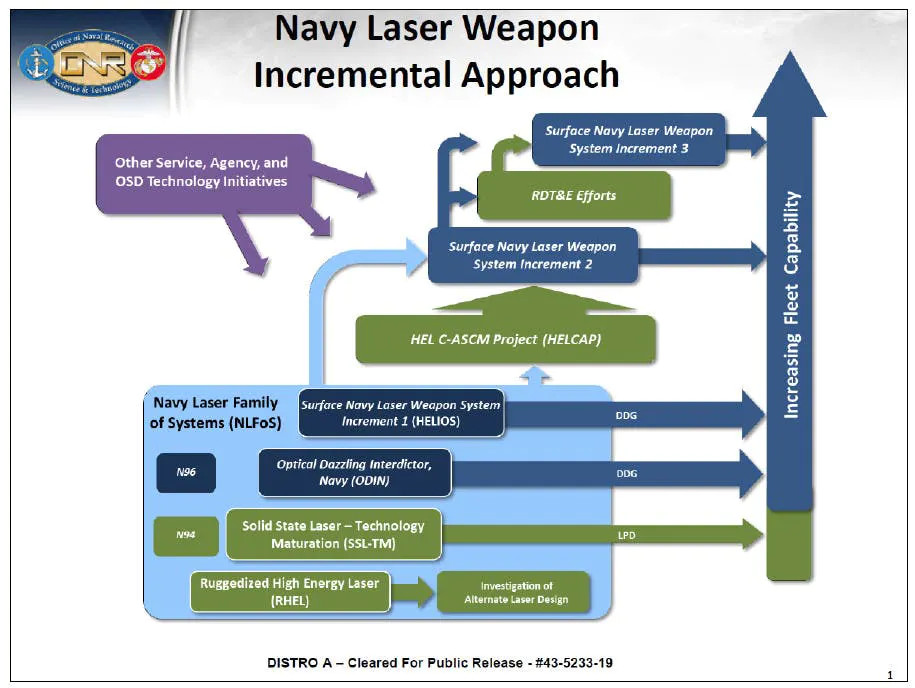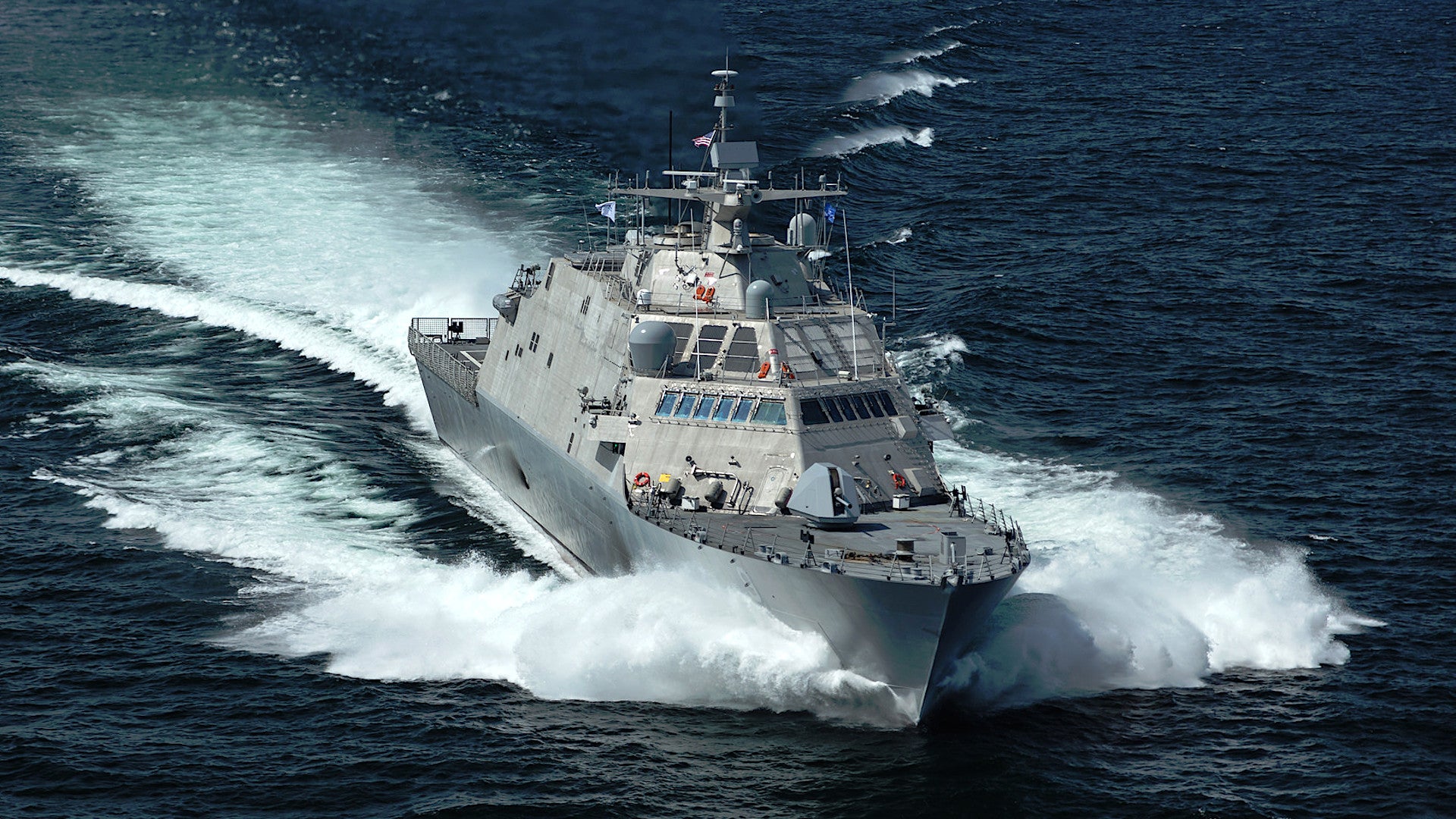The U.S. Navy says the Freedom class Littoral Combat Ship USS Little Rock will get a 150-kilowatt class laser weapon system from Lockheed Martin this year. This would make Little Rock the third of the service’s warships to be fitted with a high-power laser of some kind, following the installation of two different designs on the Arleigh Burke class destroyer USS Dewey and the San Antonio class landing platform dock amphibious ship USS Portland last year. The War Zone
was first to report that both of these vessels had gotten their respective lasers.
U.S. Navy Vice Admiral Richard Brown, Commander of Naval Surface Forces, told reporters about the impending laser installation on Jan. 13, 2020, as first reported by USNI News. At around this exact time last year, the officer had announced plans to have Little Rock deploy in early Fiscal Year 2020, which officially began on Oct. 1, 2019. If that schedule remains the same – this ship notably suffered damage after smacking into a moored vessel in Canada last year shortly after the Navy took delivery of it – the Littoral Combat Ship (LCS) could be receiving its laser very soon, if it hasn’t already, and be preparing to deploy. It is most likely headed for a cruise in Latin American waters, where its primary mission could be chasing drug smugglers, according to USNI News.
Vice Admiral Brown did not say what laser the Navy would install on Little Rock, but the most likely candidate would seem to be a variant or derivative of Lockheed Martin’s High Energy Laser and Integrated Optical-dazzler and Surveillance system, or HELIOS. Previous reports have said this laser is in the 60-kilowatt class, but that the manufacturer was looking to increase its power to the 150-kilowatt class.

As its name implies, HELIOS blends an optical dazzler, which can blind and confuse optics on hostile ships, aircraft, and drones, as well as optical seekers on missiles and other munitions, together with a high-energy laser capable of actually disabling and destroying certain targets, such as small unmanned aircraft and swarms of small boats.
Integrating HELIOS onto Little Rock would make good sense as it is one of two remaining lasers in the Navy Laser Family of Systems (NLoS) that have yet to find their way onto a ship. In November 2019, USS Dewey
emerged equipped with what appeared to be the Optical Dazzling Interdictor, Navy (ODIN) system. USS Portland
is now armed with the prototype developed under the Solid-State Laser Technology Maturation (SSL-TM) program. The service has also said that there is no immediate plan for an at-sea demonstration of a design developed under the Ruggedized High Energy Laser (RHEL) effort, the last of the four NLoS efforts.

However, if this is the case, it would also represent an important acceleration of the Navy’s plans for HELIOS, which it also refers to as the Surface Navy Laser Weapon System (SNLWS) Increment 1. Previously, the service had said that it would install this laser onto an Arleigh Burke class destroyer sometime in Fiscal Year 2021.
“The big thing we’re looking at is, what is that opportunity to pull things in – so for instance with directed energy, between the HELIOS, being able to get that onto a DDG [Arleigh Burke], and then some scalable laser technology that we’ve been working on, what’s our opportunity to deploy a laser sooner on an LCS, and the opportunity to potentially use one of those weapons modules to do that as opposed to having to design it someway into the ship?” Joe DePietro, Lockheed Martin’s Vice President and General Manager of Small Combatants and Ship Systems, told USNI News in August 2019. “Use some of that power, space, and weight of the mission package to be able to field another capability – which was inherently the thought process behind the design of LCS, to be able to integrate those new technologies faster because of the modularity of the ship.”
USNI News
has also reported that Lockheed Martin may have been able to accelerate the integration of HELIOS, or a derivative thereof, onto a Freedom class LCS because of the ship’s purpose-built modular design, which means it has significant available space and power generation. This was originally intended to support various mission modules, which have become a saga unto themselves that you can read about more in this past War Zone piece. Lockheed Martin’s shipbuilding division also designed and continues to build the Freedom class ships, giving it a deep existing knowledge of the capabilities and limitations of these vessels.
Still, DePietro’s mention of “scalable laser technology” raises questions about whether a Freedom class LCS would actually be able to support a 150-kilowatt class system, such as HELIOS, which the Navy has previously indicated would require the power generation capabilities of a significantly larger ship. So, it’s also possible that Vice Admiral Brown misspoke and the Lockheed Martin laser Little Rock is getting will be something else, perhaps with more limited capabilities, such as ODIN, which is just an optical dazzler.
Adding a laser to Little Rock could be a stepping stone to adding them to other ships in the Freedom class, as well as other similarly sized ships, such as the Independence class LCSs and the Navy’s future FFG(X) frigates. The service has already indicated that it is interested in integrating 150-kilowatt class lasers onto whatever frigate design it chooses in the end and Lockheed Martin has already bailed on competing with a ship of its own to focus on providing key systems for the remaining entrants.
DePietro had told USNI News that he saw adding a laser to one of his company’s LCSs another way to counter complaints about the ships’ limited capabilities and vulnerabilities, even in lower-risk scenarios, as well. The Navy has similarly been rushing to add RGM-148A Naval Strike Missiles to both classes of LCS to improve their offensive punch.

Of course, HELIOS by itself also simply reflects the Navy’s growing interest in laser weapon systems, in general. The service already has plans to use the systems it develops under the umbrella of the Navy Laser Family of Systems as stepping stones to even more capable designs.
Little Rock now looks set to be the next part of this new chapter in laser-armed naval operations.
Contact the author: joe@thedrive.com
